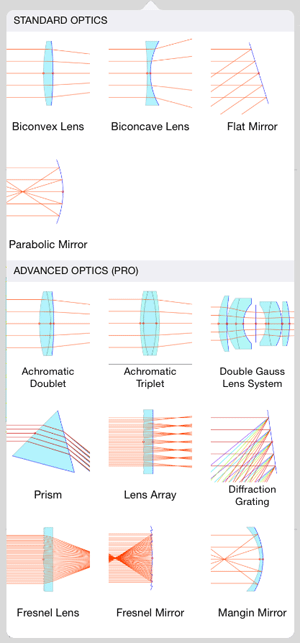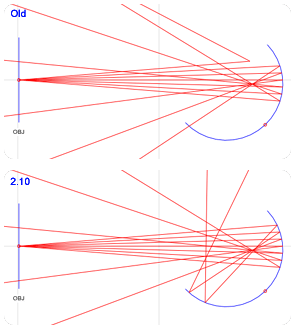Edit: The Pro in-App purchase did not show up in 2.10. This bug is fixed in 2.11.
RayLab 2.10 is part of transition to new pricing plan for RayLab. The intention is to make the RayLab app itself free. This will give access to many of RayLab’s features. But certain features are now part of the Pro in-App purchase. The Pro package is currently free, to give an opportunity to all current users to enable it at no cost. After a few weeks I will make the main App free, and switch the Pro in-App purchase to a paid item.
The Pro package currently includes the following optical elements:
- Achromatic Doublet
- Achromatic Triplet
- Double Gauss Lens System
- Prism
- Lens Array
- Diffraction Grating
- Fresnel Lens
- Fresnel Mirror
- Mangin Mirror
RayLab Pro also includes the Analysis Windows:
- Fan Ray Plot
- Wavefront Error Plot
- Grid Distortion
- Spot Diagram
- Spot Diagram (Filled)
- Chromatic Aberration
- Gaussian Spot Size
More info here on Analysis Windows.
If you try to use any of the Advanced Optics, or Analysis Windows, you will be prompted to purchase the Pro upgrade (Which is free during the transition period). Once you enable this you will have access to all Pro features even after the free period ends. Only new users would need to pay for the upgrade at that point.
If you have purchased any glass catalogs, you will continue to be able to use those regardless.
Improved Intersection Algorithm
The ray intersection algorithm has been improved to be much more accurate in the case of oblique rays and high curvature elements.


I don’t understand today’s post. Where do I transition to the pro upgrade and what does that mean? Is it a separate product? What about the glass catalogs I purchased? I found nothing on your web site that helped. Please provide more detail. Thanks.
Are you planning on adding 3×3, 4×4, or 5×5 ABCDEF matrices and their associated Gaussian Beams as discussed in Siegman’s LASERs book and Arnaud’s Beam and Fiber Optics book?
Thanks for pointing out the confusion. I just posted explanation of the Pro package here: RayLab 2.10
With regard to the ABCD matrix the short answer is I had not been planing to. But I am now thinking about the idea to see if it is feasible. I already use the 2×2 ABCD matrix for calculation of entrance pupil and Guassian beam calcs. Each surface is approximated as having spherical curvature and reduced to a 2×2 ABCD. However for Gaussian calcs I do not combine the ABCD matrices using multiplication, since that only works when all elements are on-axis. I have attempted to make the gaussian code work with off axis and rotated elements and I do this using various coordinate transformations.
I do not have copies of the two books you mention and can not find much info on the 3×3, 4×4, or 5×5 matrices online. But from what I can find it is obvious that the 3×3 matrix includes E,F terms for tilt and beam curvature. And the 4×4 and 5×5 matrices extend the method to x and y directions.
I can imagine introducing a 2×2 ABCD optical element which is a flat zero thickness element of a certain radius, and applies the ABCD terms in both x and y directions.
I can also imagine introducing a 2×2 ABCD optical element which maps rays from an input surface to an output surface.
Introducing the E,F terms would probably be feasible as well, but it seems odd to apply the same E,F value to x and y directions.
While the internal algorithms in RayLab are fully 3 dimensional, the UI is mostly 2D. Switching the UI to 3D would be quite a lot of work. The typical user would also find the app much more difficult to use. Supporting the 4×4 and 5×5 matrices seems out of place in a primarily 2D UI. To be consistent it would seem that the app would have to allow moving and rotating all optical elements in 3D. It would also need to support anisotropic elements, i.e. cylindrical lenses, etc.
Do you see a benefit in having the 2×2 ABCD element in RayLab?
I figured out why you are having issue with the Pro upgrade. There is a bug which I have just fixed in 2.11. It usually takes about a week for a new version to show up in the App Store.